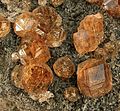Grossular
| Grossular | ||
|---|---|---|
H-M Symbol: (4/m 3 2/m) | ||
| Space group | Ia3d | |
| Identification | ||
| Color | light to dark green, light to dark yellow to reddish brown, brown, orange, red, yellow, green, white, occasionally translucent to opaque pink. It is also but rarely
found in colorless form Hessonite yellow-red to reddish-orange | |
| Tsavorite | intense green to yellowish green | |
| Leuco-garnet | transparent and colorless[3] | |
| Rosolite | translucent to opaque pink grossularite crystals in marble from Mexico | |
Grossular is a calcium-aluminium species of the garnet group of minerals. It has the chemical formula of Ca3Al2(SiO4)3 but the calcium may, in part, be replaced by ferrous iron and the aluminium by ferric iron. The name grossular is derived from the botanical name for the gooseberry, grossularia, in reference to the green garnet of this composition that is found in Siberia. Other shades include cinnamon brown (cinnamon stone variety), red, and yellow. Grossular is a gemstone.
In geological literature, grossular has often been called grossularite. Since 1971, however, use of the term grossularite for the mineral has been discouraged by the International Mineralogical Association.[4]
Hessonite

Hessonite or "cinnamon stone" is a common variety of grossular with the general
It has a characteristic red color, inclining to orange or yellow, much like that of
Hessonite comes chiefly from Sri Lanka and India, where it is found generally in placer deposits, though its occurrence in its native matrix is not unknown.[5] It is also found in Brazil and California.
Deposits
Grossular is found in
A highly sought after variety of gem garnet is the fine green Grossular garnet from Kenya and Tanzania called tsavorite. This garnet was discovered in the 1960s in the Tsavo area of Kenya, from which the gem takes its name.
Viluite is a variety name of grossular; that is not a recognized mineral species.
Grossular is known by many other names, and also some misnomers;[9] colophonite – coarse granules of garnet,[10] ernite, gooseberry-garnet – light green colored and translucent,[11] olyntholite/olytholite, romanzovite, and tellemarkite. Misnomers include[3] South African jade, garnet jade, Transvaal jade, and African jade.
Cultural significance
In 1991, Vermont named grossular garnet its state gemstone.[12]
-
Color range of grossular graphically displayed at the National Museum of Natural History Washington, D.C.
-
Group of Grossular crystals, largest 1.1 cm, fromVal-des-Sources, Quebec
See also
References
- S2CID 235729616.
- ^ ISBN 0-87311-019-6
- ^ a b Grossular The Mineral and Gemstone Kingdom, accessed online January 25, 2007
- .
- ^ a b c One or more of the preceding sentences incorporates text from a publication now in the public domain: Chisholm, Hugh, ed. (1911). "Cinnamon-stone". Encyclopædia Britannica. Vol. 6 (11th ed.). Cambridge University Press. p. 376.
- ^ Viluite Mindat database
- ^ The System of Mineralogy of James Dwight Dana. Descriptive Mineralogy By James Dwight Dana, Edward Salisbury Dana, 1892, p. 479-80
- ^ [1] Mindat database, accessed 15 October 2023
- ^ Grossular Mindat mineral database, accessed January 25, 2007
- ^ Colophonite The Free Dictionary, accessed online January 25, 2007
- ^ Gooseberry Garnet WordWeb Online
- ^ "Vermont Emblems". State of Vermont. Archived from the original on 2009-10-29. Retrieved 2009-11-12.


